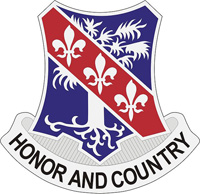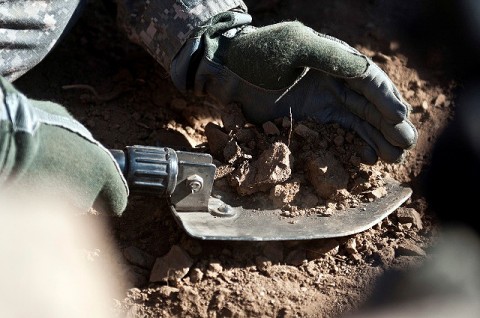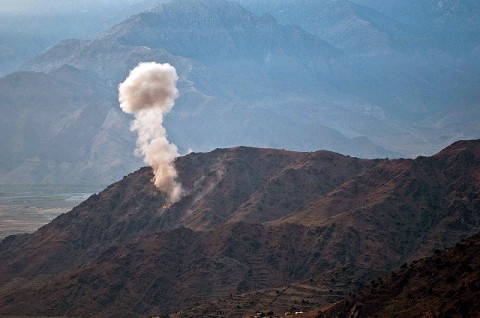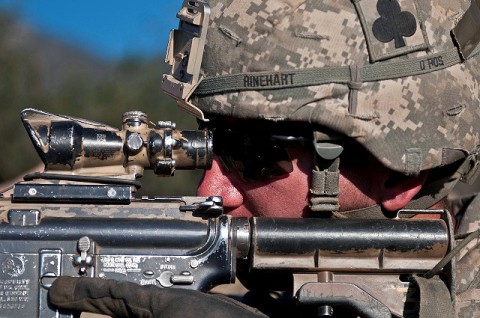Written by U.S. Army Staff Sgt. Mark Burrell
Task Force Bastogne Public Affairs

 Kunar Province, Afghanistan – Whoop. Whoop. Whoop. The sounds of helicopters echoed through the Ganjgal Valley in eastern Afghanistan’s Kunar Province the morning of December 10th.
Kunar Province, Afghanistan – Whoop. Whoop. Whoop. The sounds of helicopters echoed through the Ganjgal Valley in eastern Afghanistan’s Kunar Province the morning of December 10th.
Swarming, then hovering as expertly as hummingbirds, the CH-47 Chinooks and UH-60 Black Hawks dropped their cargo simultaneously on multiple ridges overlooking the Taliban stronghold only a few kilometers from the Pakistan border.

Within the first few minutes of the mission, it became real.
“There were a number of fighters we saw,” said U.S. Army Capt. Ryan A. McLaughlin, Bayonet Company commander, 2nd Battalion, 327th Infantry Regiment, Task Force No Slack. “You could hear them on our infill when we were moving. They did attempt to react, and very quickly they were shown that that wasn’t a very good course of action.”
Several volleys of hellfire missiles exploded, killing five insurgent fighters moving into position less than a few hundred meters away. They were armed and ready for a fight.
The light from the explosions faded and darkness reigned again. As the world slept, the Taliban stalked the Bayonet Co. Soldiers who were moving into positions high in the rocky Hindu Kush Mountains to provide maximum security for the ground assault force.
“The terrain was pretty rugged,” explained McLaughlin, a Tuscaloosa, AL, native. “We were at about 4,800 feet with elevation changes in every direction. “You go 300 meters, and you’re dropping several hundred feet. It’s pretty tricky, particularly in hours of darkness. We were looking at zero illumination with severe elevation changes.”

No matter the obstacles, the Bayonet Co. Soldiers had an essential role in the overall success of the operation.
“The over-arching concept for the mission was to disrupt what has become a safe haven for the insurgents that are in this valley,” said McLaughlin. “It’s proximity to Asad Abad, the provincial capital, was allowing the bad guys to have easy access coming through Pakistan, through this valley and into the provincial capital. Obviously that’s a problem for what we want to do … Asad Abad is the most populated area and the center of governance, so we need to protect that.”
Freezing winds whipped the rocks as the sun crawled from Pakistan over the barren mountains. Soldiers filled sandbags and built rock walls to stay warm, but more importantly, to stay safe.
“We’re (kind of) set up in a patrol base,” said U.S. Army Sgt. Joseph M. McKenzie, an infantry team leader from Chicago, also assigned to Co. B “I’m pretty sure you’ve heard, ‘You can always fix your security.’ So we keep making it better.”
McKenzie and his squad meticulously piled rock after rock giving them the best cover possible from enemy fire.
“We’re basically taking a page out of the Taliban book,” added McKenzie. “I mean, they build theirs with just rocks, but add some sandbags and it helps lock the rocks down.”
At the same time, other TF No Slack Soldiers cleared villages on the valley floor. They found eight improvised explosive devices, multiple ordnance rounds and ammunition.

“From up here, it feels pretty good to be able to give the support everybody down there needs,” said U.S. Army Pfc. Benjamin J. Lohmeyer, a rifleman from Benton, KS, also assigned to Co. B. “If something bad happens down there, we’re able to have their backs, and that feels pretty good.”
Perched high on a rocky nest with a .50-caliber machine gun, Lohmeyer and his squad had a bird’s-eye view of the action.
“Why do I do it? I don’t know why really,” Lohmeyer said. “I do it for the people back home to make sure they’re safe and so my buddies are safe … If I weren’t here today, I’d probably have some bad job back home. I’m not going to lie; I’d be trying to get money somehow just trying to get by.
Soldiers like Lohmeyer, who aren’t just trying to get by, were critical for the overall success of a mission with so many moving parts.
“We were basically able to make a fairly impenetrable cordon around the objective,” said McLaughlin. “That allowed the ground element to come in and do their clearance more quickly than I actually projected, without having to fire a single shot.”
Though Bayonet Co. Soldiers didn’t fire a single shot; 11 insurgents were killed during the operation.
“I think it was an important operation,” said McLaughlin. “We didn’t kill hundreds of insurgents or find Osama bin Laden hiding in the Ganjgal Valley, but nonetheless a very important next step in our progression. The impacts of this one will be felt in the insurgent networks.”

McLaughlin explained, “Insurgent propaganda has recently stated specifically ‘We own the Ganjgal Valley and the coalition will never set foot here again.’ And then within a matter of weeks we showed them, ‘Hey, we can come here anytime we want and we’ll do whatever we want to extend the reach of the Government of the Islamic Republic of Afghanistan.”
As darkness fell on the third night, the fatigued and sullied soldiers swiftly and silently moved out from their fighting positions. They traversed the mountains back to their landing zone and the moon glimmered off their screaming eagle patches on their shoulders.
“I think when they see the 101st patch, I don’t think its fear, but it’s (an) understanding that we mean business,” added McLaughlin. “We have the tools and the desire to apply counterinsurgency principles successfully. We’re just not here to shell the mountains and not just here to kill them, but we’re actually working on a strategic victory. I think that scares insurgents more than anything else.”
The beating of the helicopters coming to pick up the soldiers signaled yet another successful mission for TF No Slack and yet another setback for the Taliban.











